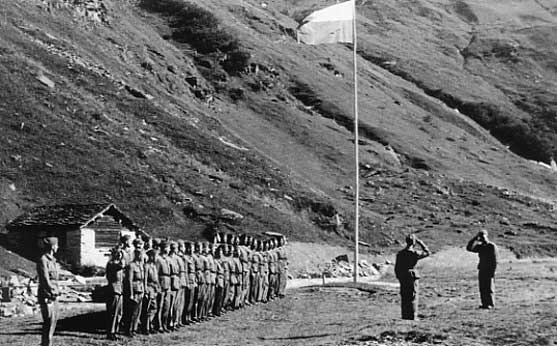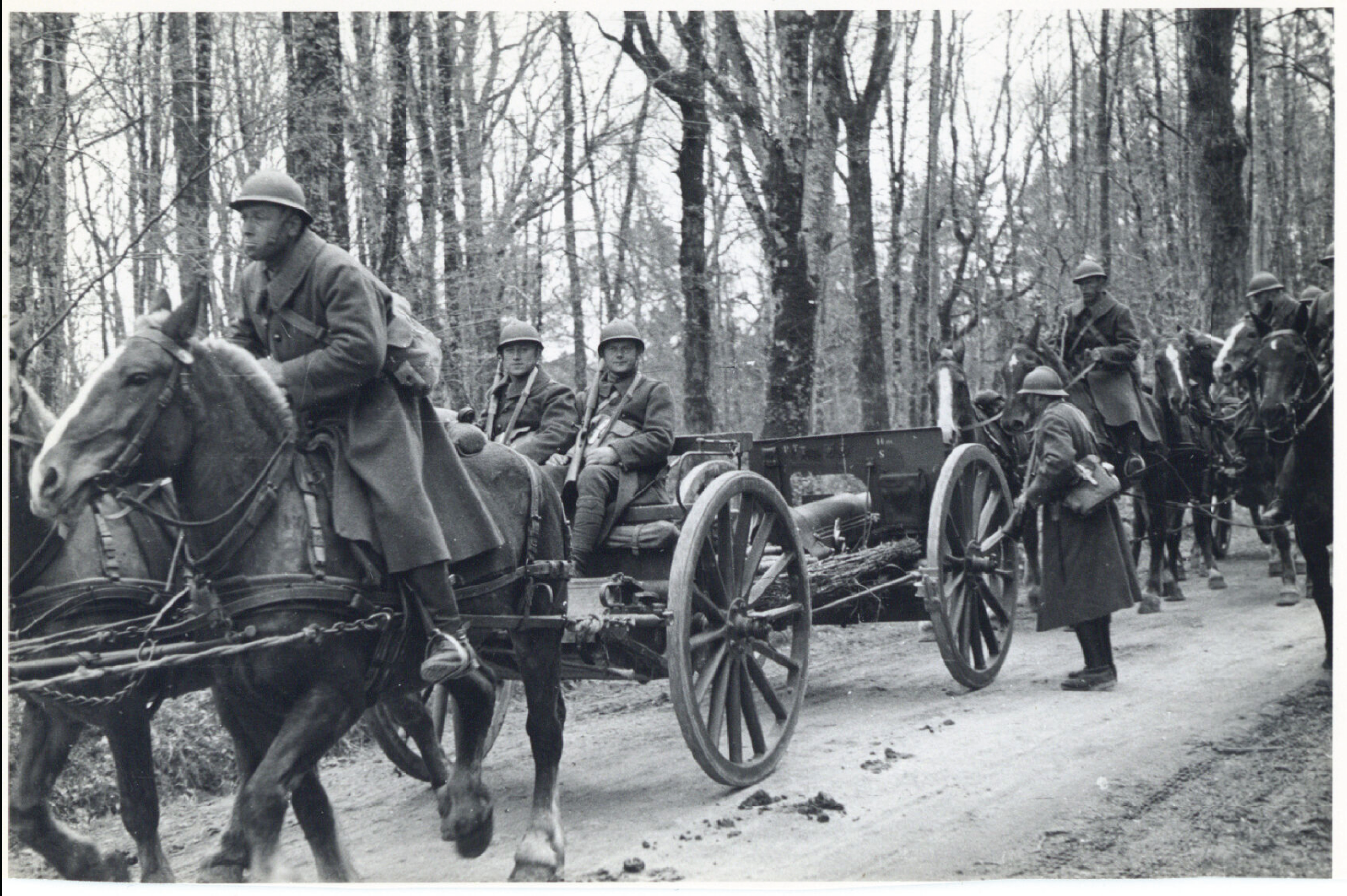| 1940: Polish Exiles
The Polish Army in
France, Part Two
By Mike Bennighof, Ph.D.
February 2024
 The story of the Polish Army in France began with Part One. The story of the Polish Army in France began with Part One.
Polish Grenadiers
Maczek had been slated to command the 1st Grenadier Division, which he handed over to Col. Bronislaw Duch in January 1940. The 1st Grenadiers, organized and equipped like a standard French infantry division, were declared combat-ready in May. They moved up behind the Maginot Line fortifications in mid-May, expecting to be sent into action, but instead built fortifications and worked on civilian water projects. Morale plummeted as news poured in of the crisis at the front, a crisis apparently not severe enough to warrant the division’s deployment.
The Polish division by this point still lacked a great deal of vital equipment, but had used its idle days to conduct still more individual and large-unit training, including division-scale maneuvers. Duch, like other Polish commanders, had thought that the order to move to the front would be accompanied by deliveries of weapons, vehicles, and ammunition, but these continued to arrive at a very slow pace.
While the Poles resented what they saw as unfair treatment, the French mobilization system had never anticipated the need to feed, clothe and arm an extra 85,000 men. Stocks of weapons and equipment had been prepared for the carefully-calculated needs of the French Army, and only in the weeks just before the German onslaught did French factories get up to wartime production speed and start churning out the additional goods needed to replace wartime losses, or fit out new émigré divisions.

Polish infantry during training, spring 1940.
On 14 June, with the French forces collapsing, the Poles finally received orders to deploy in response to German attacks on the Maginot Line. Two days after the initial attack, they took up positions along the Marne-Rhine Canal near Lagarde and fought a fierce two-day battle with German troops trying to force a crossing. Despite heavy casualties they held the canal line, but French units collapsed and the Poles once again fell back. Surrounded on the 19th, Duch led a breakout and re-formed his badly damaged division at Baccarat. There he received word of a pending armistice, and issued special code 4444 ordering his men to scatter and make their way to England or Switzerland as best they could.
Polish Rifles
To lead the 2nd Polish Rifle Division (also called the Chasseur Division, and sometimes the Fusilier Division), Sikorski chose Bronislaw Prugar-Ketling, another former Austro-Hungarian officer and the Polish Army’s pre-war Director of Infantry. He had been in charge of the ambitious program to re-equip the Polish army with semi-automatic rifles and plentiful support weapons to fight on the modern battlefield, rather than re-play the Great War or Polish-Soviet War.
While Prugar had plenty of recruits and experienced cadre, he lacked everything else and not until February 1940 was his division formally established. Without weapons of any sort, he resorted to sending his men into the nearby forests to find straight sticks that could be used as pretend rifles for tactical training. As the weeks went by, his men were joined by other patriotic Poles – Polish prostitutes flocked to the camp from all over France, offering their services at no charge to support the anti-fascist struggle. Prugar expelled them, but not before his division gained a sordid reputation with French officials. It didn’t help that the support elements somehow managed to become well-equipped with field kitchens, tents, clothing, and other comforts while the combat elements pointed sticks at each other and shouted “Bang!” The support element’s creature comforts irritated the combat troops, who for the most part slept on straw in former horse barns, and morale deteriorated.

Troops of 2nd Rifle Division near the Swiss
border.
In late May, Prugar’s division was ordered to the front, initially forming part of the reserve behind the southern end of the Maginot Line. The Poles still had not been fully equipped, with their engineer companies limited to picks and shovels, but the riflemen now received modern rifles. Like the 1st Division, the heavy artillery battalion had 220mm siege guns rather than 155mm howitzers, and even worse the other “heavy” battalion had 120mm De Bange system Model 1878 guns in place of its allotted 105mm cannon.
On 8 June, Prugar received orders to move to the front, but no more detailed instructions. After days of telephoned requests, he finally drove to French Eighth Army headquarters, where the staff remembered that the Poles existed and were expected to defend the Belfort Gap. The division moved there on the 12th, where their new corps commander, Marius Daille, welcomed them enthusiastically and showed a respect the exiles had previously felt denied by their French comrades.
On 14 June the French GHQ bypassed Daille to order one Polish regiment to re-located and support a French division, and the next day they did the same with a battalion. The Germans finally attacked the division on the morning of the 19th, touching off a fierce two-day battle at Clos-du-Doubs. As French resistance collapsed around him, Prugar followed Sikorski’s orders to take his division over the Swiss border. They crossed on the night of the 20th-21st, with the general the last man to step over the frontier at 5:30 a.m., handing his sidearm to a Swiss gendarme as a German tank rolled up behind him.
Most of the Chasseurs remained in Switzerland for the rest of the war, working on road projects and as lumberjacks; later, the Swiss government extanded free university education to the Polish soldiers. A secret agreement between the Swiss government and the Polish government-in-exile provided that the Swiss would re-arm the Polish division in case of a German invasion of Switzerland, and the Polish formation became part of Swiss defense planning. The Swiss promised a full allotment of weapons, equipment, and uniforms. Many were allowed to “escape” into France when the Allies arrived at the Swiss border in 1944, and the remainder were released after the end of the war.
Third Division
Still incomplete as the French Army collapsed, the Third Polish Infantry Division received orders from Sikorski to march south from its training camps to seek passage to England. When the reached St. Nazaire on the night of the 19th, the French Navy port commandant refused them entry. Division commander Tadeusz Zieleniewski ordered his men to break into groups of five to ten and make for England as best they could. French tuna boat captains and five British destroyers, defying the French Navy’s commands, picked up about 5,000 of the division’s troops and got them safely to British ports.

Polish recruits reporting for duty. Winter 1939.
Fourth Division
Rudolf Dreszer’s 4th Polish Infantry Division had made even less progress toward combat readiness than the 3rd Division. It had about 10,000 men at the Veluché camp when Sikorski ordered Dreszer to evacuate as many as possible to England, by way of La Rochelle. French General Victor Denain, the head of the French Military Mission to the Polish forces, ordered Dreszer to ignore Sikorski’s order and deploy his half-trained men to cover the retreat of French and British forces to the Atlantic ports. Dreszer ignored Denain instead and sent his division to La Rochelle in three echelons; the first two made it safely and about 6,000 men embarked for England on two passenger ships. Of the remaining 4,000, about half made it to England individually or in small groups, including some who hiked across Spain to Gibraltar. The remainder demobilized and scattered across France; a number would later join Polish resistance cells within France, but others refused to have anything more to do with the Allied cause.

Polish artillerymen on a training exercise.
In Summary
About 72,000 men enlisted in the Polish Army in France, not counting Air Force and Navy personnel, or the 8,000-man Polish Carpathian Brigade organizing in French-ruled Syria. Of those, 27,000 escaped to Britain, and 6,000 were demobilized in occupied France, where the Germans conscripted most of them as laborers. Another 13,000 were demobilized in what became Vichy France, where they were interned. Many of these men escaped and re-joined the Polish forces. Thirteen thousand men of the 2nd Chasseur Division sat out the war in Switzerland, and 20,000 became German prisoners of war. Almost 9,000 Poles were killed in action.
Polish leaders had hoped to eventually create an exile army of ten divisions, including a complete mechanized division. The French agreed to supply the weapons and other equipment for this force, including the tanks and vehicles for the mechanized division. But their political leaders and some generals reacted nervously to the thought of such a large foreign army on their soil, unable to return home, and slowed its development. Should the war end in a negotiated peace, the Poles would have nowhere to go.
The French high command badly mistreated Polish units during the last days of the campaign, making no special effort to evacuate them. The British seem to have had no problem with the French decision to sacrifice the Podhale Rifle brigade in front of St. Malo to allow the 1st Canadian Division and British units to safely evacuate. Both Polish infantry divisions suffered heavy losses while screening the retreat of French units.
The exile troops gave the French government plausible deniability in their armistice negotiations with the Germans. Pétain had ordered resistance to cease on the 16th, and by deploying Poles as rearguards, French commanders were not violating the letter of the old Marshal’s orders. The Polish Army in France owed its allegiance to the exiled government, not to Paris.
In military terms, the Poles added little to the defense of France – that was a French decision, not a Polish one. They dis display a fervent allegiance to the anti-fascist cause, one that would be betrayed again at Yalta in 1945. But that’s another story.
You can order 1940: Polish Exiles right here.
Polish-Lithuanian Commonwealth
The Deluge
Lithuania's Iron Wolves
Legend of the Iron Wolf
1940: Polish Exiles
Retail Price: $90.96
Package Price: $70
Gold Club Price: $56
You can join the Commonwealth right here.
Sign up for our newsletter right here. Your info will never be sold or transferred; we'll just use it to update you on new games and new offers.
Mike Bennighof is president of Avalanche Press and holds a doctorate in history from Emory University. A Fulbright Scholar and NASA Journalist in Space finalist, he has published a great many books, games and articles on historical subjects; people are saying that some of them are actually good.
He lives in Birmingham, Alabama with his wife, three children, and new puppy. He misses his lizard-hunting Iron Dog, Leopold.
Want to keep Daily Content free of third-party ads? You can send us some love (and cash) through this link right here.
|
